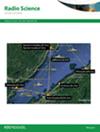中大型太阳耀斑事件中低频时码信号的变化研究
IF 1.5
4区 地球科学
Q3 ASTRONOMY & ASTROPHYSICS
引用次数: 0
摘要
本研究以中国低频时码授时系统(BPC)发射的68.5 kHz信号为基础,系统研究了中大型太阳耀斑(M/ x级)对低频时码信号的影响。通过分析20次典型耀斑事件中BPC信号的场强和时差数据,揭示了中大型太阳耀斑扰动下低频时码信号的变化规律。案例分析表明,在这种耀斑期间,BPC信号强度表现出两种响应模式:单谷结构和双谷结构。BPC信号响应分为快速变化阶段和渐变阶段,与太阳耀斑的发展具有较强的线性关系。同时,BPC定时偏差呈现双极性脉冲特征,耀斑发生后,信号性能的不稳定性与场强的双谷响应密切相关。这些现象表明,BPC时间码信号的变化与太阳耀斑期间电离层扰动对BPC地波和天波信号叠加特性的影响密切相关。本文首次系统分析了中大型太阳耀斑的低频时码信号变化,揭示了它们的响应特征。为低频时码信号传播与太阳活动的关联提供了重要见解,为提高时码信号的稳定性和可靠性奠定了坚实的理论基础。本文章由计算机程序翻译,如有差异,请以英文原文为准。
Study on the variation of low-frequency time code signals during medium to large solar flare events
This study is based on the 68.5 kHz signal transmitted by China's low-frequency time code time service system (BPC) and systematically researches the effects of medium to large solar flares (M/X-class) on low-frequency time code signals. By analyzing the field strength and timing deviation data of the BPC signal during 20 typical flare events, the study reveals the variation patterns of low-frequency time code signals under disturbances from medium to large solar flares. Case analyses indicate that, during such flares, the BPC signal intensity exhibits two response patterns: a single-valley structure and a double-valley structure. The BPC signal response is divided into two stages—a rapid change phase and a gradual change phase—which show a strong linear relationship with the development of the solar flare. Meanwhile, the BPC timing deviation displays a bipolar pulse characteristic, and after the flare, the instability in signal performance is closely associated with the double-valley response in field strength. These phenomena suggest that the changes in the BPC time code signal are closely related to the effects of ionospheric disturbances during solar flares on the superposition characteristics of the BPC ground-wave and sky-wave signals. This first systematic investigation analyzes low-frequency time-code signal variation during medium-to-large solar flares, revealing their response characteristics. It provides significant insights into the low-frequency time-code signal propagation-solar activity association and lays a solid theoretical foundation for improving time-service stability and reliability.
求助全文
通过发布文献求助,成功后即可免费获取论文全文。
去求助
来源期刊

Radio Science
工程技术-地球化学与地球物理
CiteScore
3.30
自引率
12.50%
发文量
112
审稿时长
1 months
期刊介绍:
Radio Science (RDS) publishes original scientific contributions on radio-frequency electromagnetic-propagation and its applications. Contributions covering measurement, modelling, prediction and forecasting techniques pertinent to fields and waves - including antennas, signals and systems, the terrestrial and space environment and radio propagation problems in radio astronomy - are welcome. Contributions may address propagation through, interaction with, and remote sensing of structures, geophysical media, plasmas, and materials, as well as the application of radio frequency electromagnetic techniques to remote sensing of the Earth and other bodies in the solar system.
 求助内容:
求助内容: 应助结果提醒方式:
应助结果提醒方式:


